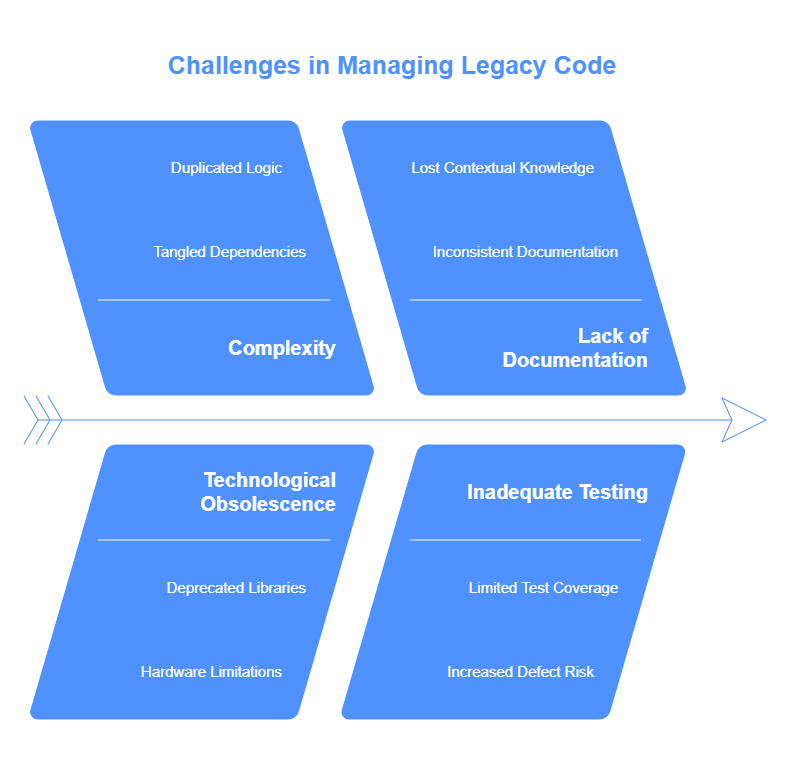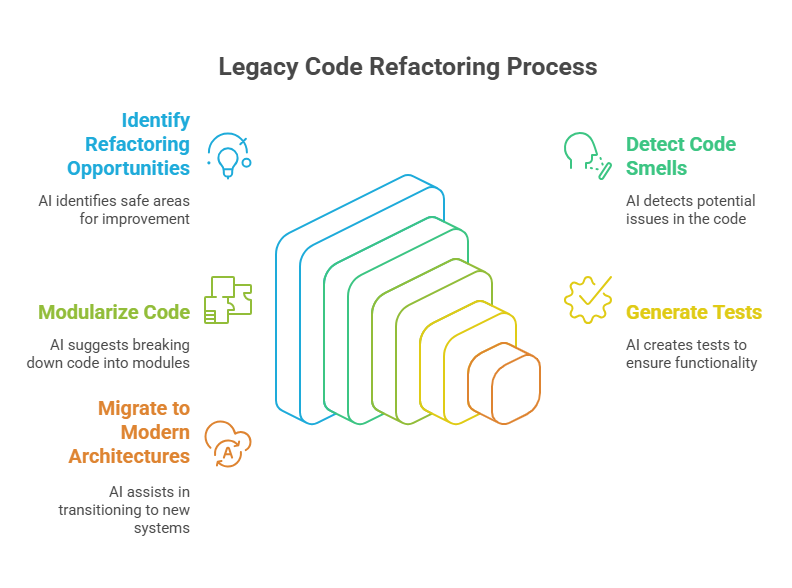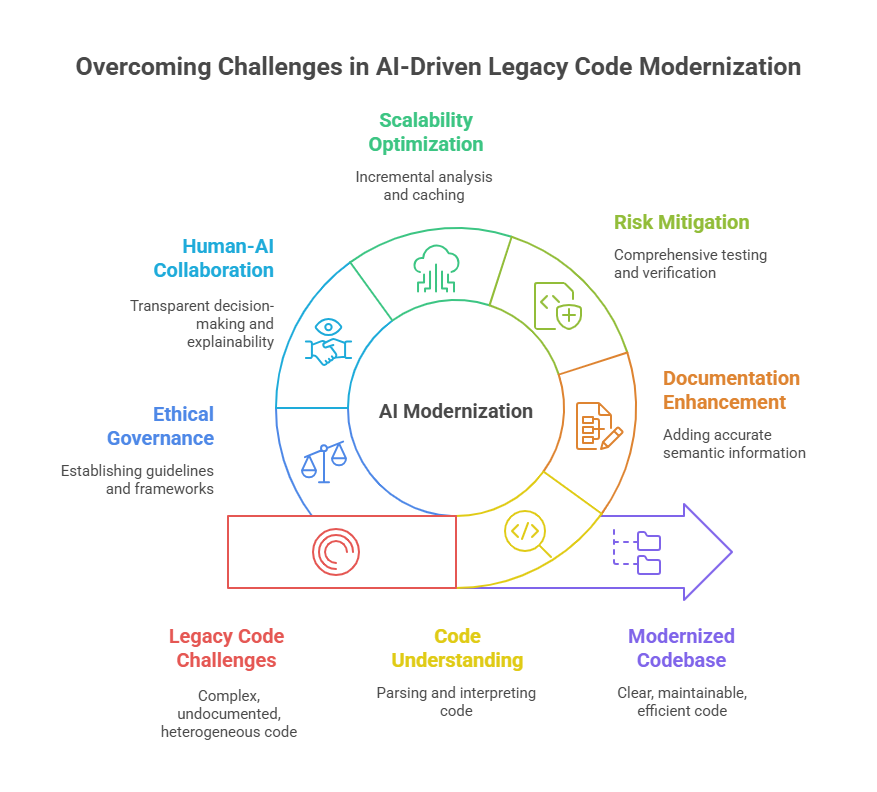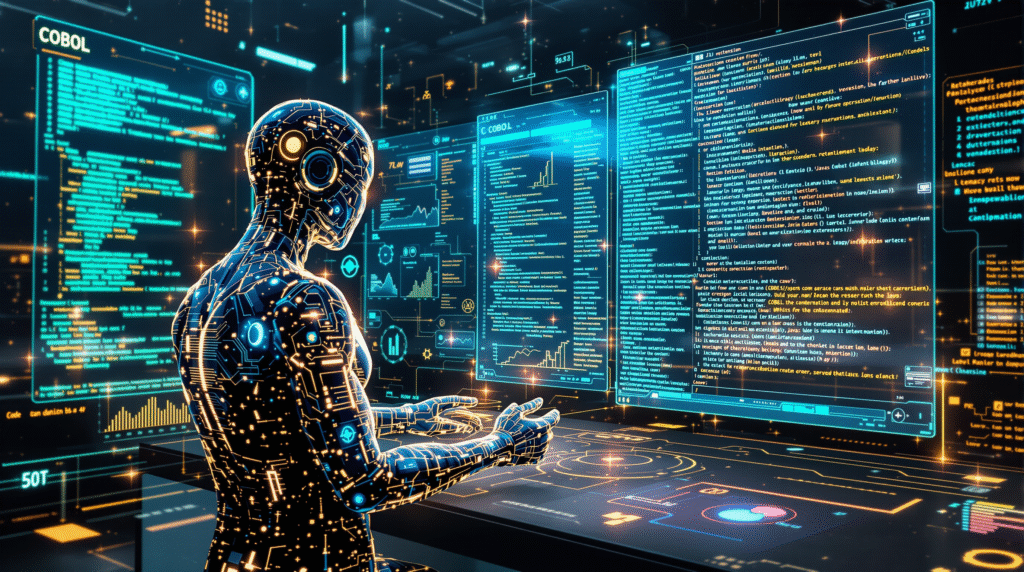Introduction
Legacy code is a critical component of many software systems that continue to operate in businesses and organizations worldwide. Despite its importance, legacy code often presents significant challenges for developers due to outdated design, lack of documentation, and accumulated technical debt. These issues can hinder maintenance, slow down feature development, and increase the risk of introducing bugs during changes.
In recent years, artificial intelligence (AI) has emerged as a powerful tool to assist in software engineering tasks, including code analysis and refactoring. AI agents—autonomous software entities capable of perceiving their environment, reasoning, and taking actions—offer promising solutions to the complexities of legacy code modernization. By leveraging machine learning, natural language processing, and advanced code analysis techniques, AI agents can help automate the understanding and improvement of legacy systems.
This article introduces the concept of designing AI agents specifically for the analysis and refactoring of legacy code. It outlines the motivations behind using AI in this domain, the potential benefits, and the challenges that must be addressed. The goal is to provide a foundation for understanding how AI-driven approaches can transform the way legacy code is maintained and evolved, ultimately leading to more reliable, maintainable, and scalable software systems.
As software systems grow in size and complexity, manual analysis and refactoring become increasingly impractical. AI agents can process vast amounts of code efficiently, identify hidden patterns and code smells, and suggest or even implement refactoring changes with minimal human intervention. This not only accelerates modernization efforts but also reduces human error and frees developers to focus on higher-level design and innovation.
In summary, the integration of AI agents into legacy code analysis and refactoring represents a significant advancement in software engineering. This introduction sets the stage for exploring the technical foundations, design principles, and practical applications of AI agents in this challenging yet vital area.
Understanding Legacy Code
Legacy code refers to existing software systems that have been developed and maintained over long periods, often using outdated technologies, programming languages, or design paradigms. These codebases are typically critical to business operations but pose unique challenges for developers tasked with maintaining or enhancing them.
One of the defining characteristics of legacy code is its complexity. Over time, multiple developers may have contributed to the code without consistent documentation or adherence to modern coding standards. This can result in tangled dependencies, duplicated logic, and convoluted control flows that make understanding the code difficult. Additionally, legacy systems often lack comprehensive test coverage, increasing the risk of introducing defects during modifications.
Another common issue is technological obsolescence. Legacy code may rely on deprecated libraries, frameworks, or hardware platforms, limiting the ability to integrate with modern tools or services. This can hinder scalability, security, and performance improvements, making refactoring or rewriting necessary.
Understanding legacy code requires not only reading and interpreting the source code but also grasping the business logic and domain-specific rules embedded within it. This contextual knowledge is often undocumented or lost as original developers leave the project, further complicating maintenance efforts.
Given these challenges, traditional manual approaches to analyzing and refactoring legacy code are time-consuming and error-prone. This is where AI agents can play a transformative role. By automating code comprehension tasks, detecting code smells, and suggesting improvements, AI agents help bridge the gap between legacy complexity and modern software engineering practices.

Fundamentals of AI Agents
AI agents are autonomous software entities designed to perceive their environment, process information, make decisions, and take actions to achieve specific goals. In the context of legacy code analysis and refactoring, AI agents serve as intelligent assistants that can understand complex codebases, identify issues, and propose or implement improvements.
At their core, AI agents consist of several key components: perception, reasoning, learning, and action. Perception involves gathering data from the environment—in this case, the legacy code and related artifacts such as documentation or version history. Reasoning enables the agent to interpret this data, detect patterns, and make informed decisions. Learning allows the agent to improve its performance over time by adapting to new information or feedback. Finally, the action component executes tasks such as generating reports, suggesting refactorings, or modifying code.
There are different types of AI agents, ranging from simple rule-based systems to complex learning agents powered by machine learning and deep learning techniques. For legacy code analysis, agents often combine static code analysis methods with natural language processing to understand code semantics and comments. Reinforcement learning and evolutionary algorithms can be employed to optimize refactoring strategies based on feedback and outcomes.
Architecturally, AI agents can be designed as standalone tools, integrated plugins within development environments, or distributed systems collaborating across multiple codebases. Their autonomy level varies from fully automated agents that perform refactoring independently to semi-autonomous assistants that require developer approval.
Understanding these fundamentals is essential for designing effective AI agents tailored to the unique challenges of legacy code. The following sections will delve deeper into specific techniques for code analysis, refactoring strategies, and how AI agents can be architected to maximize their impact in modernizing legacy systems.
Techniques for Code Analysis
Effective analysis of legacy code is a critical step toward successful refactoring and modernization. AI agents rely on a variety of code analysis techniques to extract meaningful information from complex and often poorly documented codebases. These techniques can be broadly categorized into static analysis, dynamic analysis, and hybrid approaches.
Static Analysis involves examining the source code without executing it. AI agents use static analysis to parse code syntax, build abstract syntax trees (ASTs), and identify structural elements such as classes, functions, and variables. This enables detection of code smells, duplicated code, dead code, and violations of coding standards. Advanced static analysis can also infer data flow, control flow, and dependencies between components, providing a comprehensive understanding of the codebase’s architecture.
Dynamic Analysis complements static methods by observing the program’s behavior during execution. AI agents can instrument legacy systems to collect runtime data such as function call sequences, memory usage, and performance metrics. This information helps identify bottlenecks, runtime errors, and unexpected behaviors that static analysis might miss. Dynamic analysis is particularly useful for legacy code with complex interactions or when source code is incomplete.
Hybrid Approaches combine static and dynamic analysis to leverage the strengths of both. For example, AI agents might use static analysis to identify suspicious code regions and then apply targeted dynamic analysis to validate hypotheses or gather additional context. This integrated approach enhances accuracy and reduces false positives.
In addition to these traditional techniques, AI agents increasingly employ machine learning and natural language processing (NLP) to analyze code comments, commit messages, and documentation. NLP helps bridge the gap between human-readable descriptions and code semantics, improving the agent’s ability to understand intent and context.
Refactoring Strategies for Legacy Code
Refactoring legacy code involves restructuring existing code without changing its external behavior to improve readability, maintainability, and extensibility. Given the complexity and fragility of legacy systems, effective refactoring strategies must be carefully planned and executed to minimize risks.
One common approach is incremental refactoring, where changes are made in small, manageable steps rather than large-scale rewrites. This reduces the chance of introducing errors and allows continuous validation through testing. AI agents can assist by identifying safe refactoring opportunities and suggesting sequences of changes that preserve functionality.
Code smell detection is another key strategy. Code smells are indicators of potential problems, such as duplicated code, long methods, or excessive coupling. AI agents use pattern recognition and machine learning to detect these smells automatically, prioritizing them based on severity and impact.
Modularization is often necessary to break down monolithic legacy systems into smaller, loosely coupled components. AI agents can analyze dependencies and suggest ways to encapsulate functionality into modules or services, facilitating easier maintenance and future enhancements.
Automated testing and test generation play a crucial role in refactoring legacy code. Since legacy systems often lack comprehensive tests, AI agents can generate test cases based on code analysis and execution traces, ensuring that refactoring does not alter expected behavior.
Migration to modern architectures such as microservices or cloud-native platforms may be part of the refactoring process. AI agents can help map legacy components to new architectural patterns, estimate migration effort, and automate parts of the transformation.
Throughout these strategies, collaboration between AI agents and human developers is essential. AI agents provide data-driven recommendations and automate routine tasks, while developers apply domain knowledge and make final decisions.

Designing AI Agents for Automated Code Analysis
Designing AI agents for automated code analysis involves creating systems that can intelligently parse, interpret, and assess legacy codebases. These agents must combine robust architectural design with advanced algorithms to handle the complexity and diversity of real-world software.
Architectures for Code Analysis Agents
A typical AI agent for code analysis consists of several core components:
Parser: Converts source code into an abstract syntax tree (AST) or other intermediate representations, enabling structural analysis.
Feature Extractor: Gathers relevant features from the code, such as function lengths, dependency graphs, and code smells.
Reasoning Engine: Applies rules, heuristics, or machine learning models to interpret extracted features and assess code quality.
Recommendation Module: Suggests improvements, refactorings, or highlights problematic areas.
Feedback Loop: Incorporates user feedback or test results to refine future analyses.
These components can be orchestrated in a modular architecture, allowing for extensibility and integration with other tools. Modern agents often leverage deep learning for pattern recognition and natural language processing to interpret comments and documentation.
Algorithms and Techniques
Static Analysis: Uses ASTs and control/data flow graphs to detect issues without executing code.
Machine Learning: Trains models on labeled code samples to predict code smells, bugs, or refactoring opportunities.
Natural Language Processing (NLP): Analyzes comments, commit messages, and documentation to enhance code understanding.
Graph-Based Methods: Represents code as graphs (e.g., call graphs, dependency graphs) for advanced structural analysis.
Python Example: Simple AI Agent for Code Smell Detection
Below is a Python example of a basic AI agent that parses Python code, builds an AST, and detects a simple code smell: functions that are too long (exceeding a specified number of lines).
python
import ast
class CodeSmellAgent(ast.NodeVisitor):
def __init__(self, max_function_length=20):
self.max_function_length = max_function_length
self.long_functions = []
def visit_FunctionDef(self, node):
start_line = node.lineno
end_line = max([n.lineno for n in ast.walk(node) if hasattr(n, 'lineno')], default=start_line)
length = end_line - start_line + 1
if length > self.max_function_length:
self.long_functions.append((node.name, length, start_line))
self.generic_visit(node)
def analyze(self, code):
tree = ast.parse(code)
self.visit(tree)
return self.long_functions
# Example usage
if __name__ == "__main__":
sample_code = '''
def short_function():
return 42
def long_function():
for i in range(30):
print(i)
# Imagine many more lines here
return "done"
''' + "\n" * 25 # Simulate a long function
agent = CodeSmellAgent(max_function_length=10)
results = agent.analyze(sample_code)
for name, length, line in results:
print(f"Function '{name}' is too long ({length} lines, starts at line {line})")How It Works:
The agent uses Python’s ast module to parse code and traverse function definitions.
For each function, it calculates the number of lines.
If a function exceeds the specified length, it is flagged as a code smell.
The agent can be extended to detect other smells or integrated into larger analysis pipelines.
AI-Driven Refactoring Approaches
AI-driven refactoring leverages intelligent agents to autonomously suggest, prioritize, and even apply changes to legacy codebases, aiming to improve code quality, maintainability, and performance without altering external behavior. These approaches combine code analysis, machine learning, and automated transformation techniques to streamline the modernization process.
Suggestion of Refactoring Opportunities
AI agents analyze code to detect patterns indicative of refactoring needs, such as code smells, duplicated code, or complex methods. Using supervised learning models trained on labeled datasets of refactored and non-refactored code, agents can predict which parts of the code would benefit most from refactoring. Reinforcement learning can also be employed, where agents learn optimal refactoring sequences by maximizing code quality metrics over time.
Prioritization of Refactoring Tasks
Not all refactoring opportunities are equally urgent or impactful. AI agents prioritize tasks based on factors like code criticality, frequency of use, and potential risk. Multi-criteria decision-making algorithms help balance trade-offs between effort and benefit, ensuring that the most valuable refactorings are addressed first.
Autonomous Application of Refactorings
Advanced AI agents can automatically apply refactoring transformations, such as method extraction, renaming, or modularization. These agents use program transformation frameworks to modify the code while preserving correctness. Automated testing and verification are integrated to validate that behavior remains unchanged.
Human-in-the-Loop Collaboration
Despite automation, human oversight remains crucial. AI agents provide explanations and confidence scores for their suggestions, enabling developers to review and approve changes. This collaboration enhances trust and leverages human expertise alongside AI efficiency.
Example: Automated Method Extraction
Consider an AI agent that identifies long methods and automatically extracts coherent code blocks into new methods to improve readability. The agent uses code analysis to detect candidate blocks, applies transformation rules, and updates call sites accordingly.
Integration with Development Environments
Embedding AI agents into development environments is essential for seamless legacy code modernization. By integrating with Integrated Development Environments (IDEs) and Continuous Integration/Continuous Deployment (CI/CD) pipelines, AI agents can provide real-time assistance, automate routine tasks, and ensure continuous code quality improvements.
Integration with IDEs
AI agents embedded in IDEs offer developers immediate feedback during coding and refactoring. Features include automatic detection of code smells, suggestions for improvements, and inline explanations. This integration enhances developer productivity by reducing context switching and enabling interactive collaboration with AI.
Popular IDEs like Visual Studio Code, IntelliJ IDEA, and PyCharm support plugins or extensions that can host AI agents. These plugins can analyze code as it is written, highlight potential issues, and propose refactorings. Additionally, AI agents can assist with code completion, documentation generation, and debugging.
Integration with CI/CD Pipelines
Incorporating AI agents into CI/CD pipelines enables automated code analysis and refactoring checks during build and deployment processes. Agents can run static and dynamic analyses on every commit, flagging regressions or new code smells before code reaches production.
Automated refactoring suggestions can be integrated into pull request workflows, where AI agents comment on code changes and recommend improvements. This continuous feedback loop helps maintain code quality over time and reduces technical debt accumulation.
Benefits of Integration
Real-Time Assistance: Developers receive instant insights and suggestions.
Automation: Routine code quality checks and refactorings are automated.
Collaboration: AI agents become part of the development team’s workflow.
Scalability: Large codebases are continuously monitored without manual effort.
Challenges
Integration requires careful design to avoid performance overhead and ensure compatibility with diverse development tools. User experience must balance helpfulness with non-intrusiveness to gain developer trust.
Challenges and Limitations
While AI agents offer promising capabilities for legacy code modernization, several challenges and limitations must be addressed to ensure effective and reliable deployment.
Code Complexity and Diversity
Legacy codebases often contain complex, poorly documented, and heterogeneous code written in multiple languages and styles. This diversity makes it difficult for AI agents to generalize analysis and refactoring strategies across different projects. Handling intricate dependencies, platform-specific code, and outdated constructs requires sophisticated parsing and interpretation capabilities.
Incomplete or Outdated Documentation
Many legacy systems suffer from missing, outdated, or inconsistent documentation, limiting the AI agent’s ability to understand code intent and context. Without accurate semantic information, agents may misinterpret code behavior, leading to incorrect suggestions or risky refactorings.
Risk Management and Safety
Automated refactoring carries the risk of introducing bugs or breaking functionality, especially in critical systems. Ensuring behavioral preservation requires comprehensive testing, formal verification, or rollback mechanisms. AI agents must balance aggressiveness in refactoring with caution to avoid destabilizing the codebase.
Scalability and Performance
Analyzing large legacy codebases demands significant computational resources. AI agents must optimize performance to provide timely feedback without disrupting developer workflows. Incremental analysis and caching strategies can help manage scalability.
Human-AI Collaboration
Trust and acceptance of AI agents depend on transparent decision-making and explainability. Developers need clear explanations for AI suggestions and the ability to override or customize agent behavior. Poorly designed interfaces or opaque recommendations can hinder adoption.
Ethical and Legal Considerations
Automated code modification raises questions about accountability, intellectual property, and compliance with coding standards or regulations. Establishing guidelines and governance frameworks is essential for responsible AI agent deployment.
Summary
Despite their potential, AI agents face significant challenges in legacy code modernization related to code complexity, documentation gaps, risk management, scalability, human collaboration, and ethical concerns. Addressing these limitations through research and careful design is critical to unlocking the full benefits of AI-driven refactoring.

Case Studies and Industry Applications
AI agents have been successfully applied to refactor legacy codebases across various industries, demonstrating their ability to improve code quality, reduce technical debt, and accelerate modernization efforts.
Case Study 1: Financial Services
A leading bank used AI agents to analyze and refactor their legacy mainframe applications. The agents identified redundant code, outdated patterns, and security vulnerabilities, automating much of the refactoring process. This resulted in a 40% reduction in maintenance costs and improved system performance.
Case Study 2: Healthcare
A healthcare provider integrated AI agents to modernize their electronic health record (EHR) system. The agents helped migrate legacy code to a microservices architecture, improving scalability and enabling faster feature development while ensuring compliance with regulatory standards.
Case Study 3: Manufacturing
An industrial manufacturer employed AI agents to refactor their legacy control software. The agents detected complex code segments and suggested modularization strategies, which enhanced maintainability and reduced downtime caused by software errors.
Case Study 4: Retail
A retail company leveraged AI agents to clean up and optimize their legacy e-commerce platform. Automated refactoring improved page load times and streamlined integration with modern payment gateways, boosting customer satisfaction and sales.
These examples highlight the versatility and effectiveness of AI agents in tackling diverse legacy modernization challenges, enabling organizations to extend the life and value of their software assets.
Future Directions and Research Opportunities
The field of AI-driven legacy code refactoring is rapidly evolving, with several promising research directions and technological advancements on the horizon.
Advanced Program Understanding
Improving AI agents’ ability to comprehend complex code semantics, dependencies, and business logic will enhance their refactoring precision and safety.
Explainable AI
Developing transparent AI models that provide clear rationales for refactoring suggestions will increase developer trust and facilitate human-AI collaboration.
Hybrid Human-AI Workflows
Research into effective collaboration models where AI agents assist but do not replace human judgment will optimize modernization outcomes.
Cross-Language and Cross-Platform Refactoring
Expanding AI capabilities to handle multi-language codebases and heterogeneous platforms will address real-world software diversity.
Integration with DevOps and Continuous Delivery
Embedding AI-driven refactoring into automated pipelines will enable continuous modernization aligned with agile development practices.
Ethical and Security Considerations
Ensuring AI agents operate responsibly, respecting privacy, security, and intellectual property rights, remains a critical area of focus.
By pursuing these directions, the next generation of AI agents will become more intelligent, reliable, and integral to sustainable software evolution.
The AI Agent Revolution: Changing the Way We Develop Software
Intelligent Agents: How Artificial Intelligence Is Changing Our World
Agents AI: A New Era of Automation and Intelligent Decision-Making in Business


